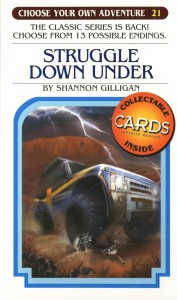I read through the entirety of the Choose Your Own Adventure book Struggle Down Under the other day and feel I need to share my thoughts.
(You may remember this book from the 1988 publication title Terror In Australia. If you read it back then, rest assured it is the same book with only a few minor updates.)
Struggle Down Under (hereafter referred to as SDU) follows the typical choose-your-own-adventure route of presenting a story that occasionally branches, leaving the decision of what to do next up to the player. In this tale there are a total of 13 endings – some good and some bad. I think Karianne Moorhouse (age 12) said it best when she enthused: “I love all the different endings. Your choices decide the outcomes.”
In this book you play a young Australian fellow who receives a call from his uncle asking for assistance on an archaeological dig. It turns out the uncle has discovered evidence of the lost civilization of ‘Satyrion’ and all manner of ne’er-do-wells are after him. What follows is a strangely abbreviated adventure mostly concerned with getting to the outback and not that much involved with what happens when you arrive. There are very few choices in total (maybe half a dozen) and, as mentioned, 13 endings. Quite a few of the endings are bad – even ghastly – and I can only imagine what younger readers may make of such events as a companion dying and another getting his leg crushed before you eventually die of dehydration yourself.
Of course, as Jessa Sargent (age 11) says, this may be part of the appeal: “I like to choose which way to go and then go back if I made a bad decision.”
SDU includes some bold speculations on the nature of human history. Satyrion itself is a prehistoric superpower possessed of astounding supertechnology who fled the Earth aeons ago. They make an appearance in the book in person (the excitement of the reveal is tempered by the knowledge they are not aliens at all). Certain supernatural powers of indigenous people are hinted at in the text as well. I was tempted to read between the lines and suppose the author was suggesting that aborigines are in fact descendents of the Satyrion?
But what of the quality of SDU? What emotion does it instill in the reader? How does it keep the pages turning? It is with some regret I must admit hardly at all. In fact, during the ten odd minutes I spent reading the book (including all endings) I found myself repeatedly coming to a striking conclusion, best summarized by a comment I made at the time to KLS…
“In the history of the Earth, this is the worst book ever printed.” (Me, age 38)
Of course it has been suggested that I tend to the hyperbolic, but mark my words: Struggle Down Under is a book for babies, not men.
My hope is that other titles in the series, such as War With The Mutant Spider Ants or Ninja Cyborg present a more compelling tale than Struggle Down Under.

